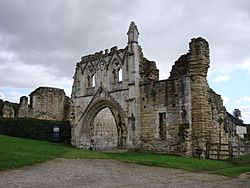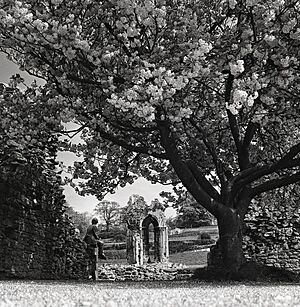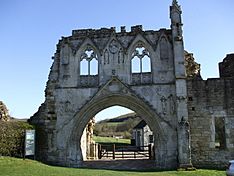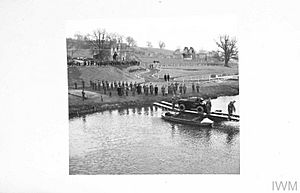Kirkham Priory facts for kids
Quick facts for kids Kirkham Priory |
|
|---|---|
 |
|
| Location | Kirkham, North Yorkshire |
| Nearest city | York |
| Built | 12th century |
|
Listed Building – Grade I
|
|
| Official name: Kirkham Priory | |
| Designated | 11 February 1987 |
| Reference no. | 1149116 |
| Official name: Kirkham Priory Augustinian monastery: monastic precinct, three fishponds, and precinct boundary | |
| Designated | 9 October 1981 |
| Reference no. | 1014024 |
| Lua error in Module:Location_map at line 420: attempt to index field 'wikibase' (a nil value). | |
The Kirkham Priory is a set of old ruins located by the River Derwent. You can find it in a place called Kirkham, in North Yorkshire, England.
This priory was a special kind of monastery. It was built in the 1120s by a group of monks called the Augustinians. A powerful lord named Walter l'Espec, who lived nearby in Helmsley, started the priory. He also helped build another famous place, Rievaulx Abbey.
A sad legend says that Walter l'Espec built Kirkham Priory to remember his only son. His son supposedly died nearby after his horse got scared by a wild boar.
The priory was closed down on December 8, 1539. This happened during a time called the Dissolution of the Monasteries. This was when King Henry VIII closed many monasteries in England.
Much later, during the Second World War, the area around the priory was used for important tests. Soldiers practiced with vehicles for the D-Day landings here. Even Winston Churchill, who was the Prime Minister at the time, visited the site.
Today, the ruins are very important. They are protected as a Grade I listed site and a scheduled monument. This means they are very old and special. English Heritage now looks after them.
The Priory's Gatehouse
The Gatehouse at Kirkham Priory was built around 1290 to 1295. It is a great example of English Gothic style from the Middle Ages. It's quite rare to find a gatehouse like this still standing today.
The gatehouse has a wide arch with fancy carvings. Above the arch, you can see sculptures of famous figures. On the left, there is St George and the Dragon. On the right, you can see David and Goliath. Higher up, there is a carving of Christ. Below him are two more figures, St Bartholomew and St Philip, in special carved spaces.
You can also spot many shields on the gatehouse. These shields show the coats of arms of important families. These families gave money or help to the Priory a long time ago. Some of the families include de Ros, Scrope, de Forz, Vaux, FitzRalph, and Espec. The Espec family shield even has three cart-wheels on it!
 The shield of the Scrope family.
The shield of the Scrope family. The shield of the de Forz family.
The shield of the de Forz family. The shield of the de Clare family.
The shield of the de Clare family. The shield of the de Ros family.
The shield of the de Ros family.
Important Burials at the Priory
Many important people were buried at Kirkham Priory over the centuries. These included members of noble families. For example, several members of the de Ros family, who were powerful lords, were laid to rest here. This shows how important the priory was to the local community and powerful families.
Kirkham Priory and D-Day Training
During the Second World War, Kirkham Priory played a secret and very important role. It became a training ground for the D-Day landings. D-Day was a massive invasion by sea that happened on June 6, 1944. It was the largest invasion of its kind in history.
The British 11th Armoured Division trained at Kirkham. Their drivers practiced moving tanks, jeeps, and other military vehicles. They also tested special materials to make sure vehicles could go through water. This training helped them get ready for the invasion.
Soldiers also used the high walls of the priory's Western Cloister. They practiced climbing up scrambling nets. These nets were like the ones they would use to get from big transport ships into smaller landing boats during the actual invasion.
The training at Kirkham was so important that top leaders visited. Prime Minister Winston Churchill and King George VI came to the priory in secret. They wanted to see how the preparations were going. This shows just how vital Kirkham's role was in getting ready for D-Day.




